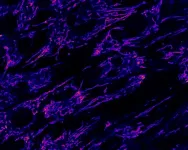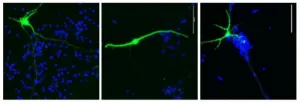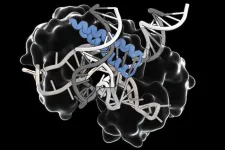(Press-News.org) Red blood cells carry oxygen from the lungs to every other organ, and blood-forming stem cells must make about 200 billion new red blood cells each day to keep the oxygen flowing.
For many years, scientists assumed that blood production took place in the bone marrow. But now, researchers at UCSF are showing it’s also happening in the lungs.
They found hematopoietic stem cells (HSCs) in human lung tissue that make red blood cells, as well as megakaryocytes, which produce the platelets that form blood clots. The findings appear Feb. 27 in Blood.
The work, which was supported by the National Heart, Lung, and Blood Institute (NHLBI) of the National Institutes of Health (NIH), suggests the lungs could be a potent source for life-saving stem cell transplants.
“For decades, bone marrow transplants have been a lynchpin in the treatment of cancers like leukemia,” said Mark Looney, MD, professor of medicine and laboratory medicine at UCSF and senior author of the paper. “The lung HSCs could prove to be a second and significant reservoir of these precious stem cells.”
From mouse to human
In 2017, the UCSF team found cells in the mouse lung making 50% of the mouse’s platelets.
They also discovered lung stem cells in mice that made all the constituents of blood, including red blood cells, megakaryocytes and several types of immune cells.
Looney’s group wanted to prove this was also happening in people. So, they obtained donated samples of lung, bone marrow and blood, and compared what they found in each tissue.
Screening a golf-ball-sized volume of lung tissue, the scientists found stem cells in the lung that strongly resembled the well-known HSCs of bone marrow. Surprisingly, the HSCs were found at similar rates in both lung and bone marrow.
“The lung HSCs weren’t one-offs – they were a reliable presence in the lungs,” said Catharina Conrad, MD, PhD, postdoctoral scholar in Looney’s lab and first author of the paper. “But we still needed to know that they were actually capable of making blood.”
So, the scientists coaxed lung and bone marrow HSCs to mature in petri dishes and found the lung HSCs were productive just like the bone marrow HSCs.
“Both types of HSCs thrived in our gold-standard stem cell experiment, but the lung HSC colonies made more red blood cells and megakaryocytes, while the bone marrow colonies tended to make more immune cells,” Looney said.
The human lung HSCs also could restore bone marrow in HSC-deficient mice. The discovery confirmed Looney’s earlier discovery that the mouse lung and bone marrow complemented one another in producing blood, even sending stem cells to restore one another.
“We think these HSCs could be a reservoir of hematopoiesis in a particular organ, in this case the lung, that gets activated whenever the body needs more of any part of the blood, whether it’s platelets, red blood cells or immune cells,” Looney said.
Getting to know the new HSC in town
To show that the lung HSCs truly resided in the lung, and weren’t just escapees from the bone marrow, Conrad and Looney looked for the HSCs in human lung tissue samples.
They found them between blood vessels in an arrangement that was reminiscent of what’s seen in bone marrow.
“They really seem to live there and aren’t just passing through,” Conrad said.
Lastly, the team analyzed the output of routine bone marrow transplants, which today begin with a blood draw from a donor followed by a screen for stem cells.
Remarkably, nearly a fifth of the stem cells isolated for bone marrow transplant carried the signature of lung HSCs – suggesting that cells in “bone marrow transplants” aren’t only from bone marrow.
There’s a lot more to learn about the lung HSCs. Could the different pools of HSCs serve different therapeutic roles in medicine? Why do the lungs themselves need to make blood?
“The lungs are critical to blood circulation, so it’s tantalizing to see the lung HSCs as an emergency reservoir for red blood cell and platelet production,” Looney said. “Now that we know they exist, it opens up a lot of new opportunities for a therapy, hematopoietic stem cell transplantation, that is very commonly used for patients with the need.”
Authors: Other UCSF authors are Mélia Magnen, PhD, Jessica Tsui, Harrison Wismer, Mohammad Naser, MSc, Urmila Venkataramani, Bushra Samad, MS, Simon J. Cleary, PhD, Longhui Qiu, Jennifer J. Tian, MA, Marco De Giovanni, PhD, Andrew D. Leavitt, MD, and Alexis J. Combes, PhD. For all authors see the paper.
Funding: This work was supported in part by the Wellcome Trust, the UKRI Medical Research Council, the National Institutes of Health (R35HL161241, 1S10OD028511-01). For all funding and disclosures, see the paper.
About UCSF: The University of California, San Francisco (UCSF) is exclusively focused on the health sciences and is dedicated to promoting health worldwide through advanced biomedical research, graduate-level education in the life sciences and health professions, and excellence in patient care. UCSF Health, which serves as UCSF's primary academic medical center, includes top-ranked specialty hospitals and other clinical programs, and has affiliations throughout the Bay Area. UCSF School of Medicine also has a regional campus in Fresno. Learn more at ucsf.edu, or see our Fact Sheet.
###
Follow UCSF
ucsf.edu | Facebook.com/ucsf | YouTube.com/ucsf
END
How our lungs back up the bone marrow to make our blood
A study of human lung samples reveals a potent new source of hematopoietic stem cells, which make red blood cells, platelets, and immune cells.
2025-02-27
ELSE PRESS RELEASES FROM THIS DATE:
Fat transport deficiency explains rare childhood metabolic crises
2025-02-27
Researchers studying a protein linked to a rare, severe disease have made a discovery that sheds light on how cells meet their energy needs during a severe metabolic crisis. The findings could lead to new treatments for the disease and open new avenues of research for other conditions involving impaired fat metabolism.
When scientists at the Centre for Genomic Regulation (CRG) in Barcelona first identified a handful of protein-coding genes called TANGO in 2006, they had no idea that one of them, TANGO2, would eventually be linked to a life-threatening ...
Remote work “a protective shield” against gender discrimination
2025-02-27
February 27, 2025
Remote work “a protective shield” against gender discrimination
Survey of more than 1000 women shows incidence higher on-site versus out of the office
Toronto - Having staff physically in the workplace benefits companies and employees through stronger team collaboration and informal mentorship.
But as organizations continue to corral employees back into the office, they should recognize that women pay a price through increased exposure to gender discrimination, says a new study from the University of Toronto’s Rotman School of Management.
In ...
How air pollution and wildfire smoke may contribute to memory loss in Alzheimer’s disease
2025-02-27
LA JOLLA, CA—Air pollution contributes to nearly 7 million premature deaths each year, and its effects go far beyond the lungs. Breathing in wildfire smoke or automobile-related city smog doesn’t just increase the risk of asthma and heart disease—it may also contribute to brain diseases as diverse as Alzheimer’s and autism.
Scientists at Scripps Research have discovered how a chemical change in the brain—which can be triggered by inflammation and aging as well as toxins found in air pollution, pesticides, wildfire smoke and processed meats—disrupts normal brain cell function. Known as S-nitrosylation, ...
UAF scientist designing satellite to hunt small space debris
2025-02-27
A University of Alaska Fairbanks scientist is participating in a U.S. government effort to design a satellite and instruments capable of detecting space debris as small as 1 centimeter, less than one-half inch.
Debris that small, which cannot currently be detected from the ground, can damage satellites and other spacecraft in low-Earth orbit.
The idea is to outfit future satellites, such as those vital for communication systems, with technology to avoid space debris collisions.
Space debris travels ...
Innate immune training aggravates inflammatory bone loss
2025-02-27
Clinical research has long focused on ways to harness the actions of the immune system. From vaccines to immunotherapies, researchers have used their knowledge of the immune system to develop therapies to treat or prevent diseases from influenza to autoimmune disease and cancer.
Now, researchers from Penn’s School of Dental Medicine and international collaborators have investigated the effects of training the innate immune system in experimental models of two chronic inflammatory diseases, periodontitis and arthritis. They found that this “trained” immunity, or TRIM, led to increased bone loss in these models. This ...
An ancient RNA-guided system could simplify delivery of gene editing therapies
2025-02-27
A vast search of natural diversity has led scientists at MIT’s McGovern Institute and the Broad Institute of MIT and Harvard to uncover ancient systems with potential to expand the genome editing toolbox. These systems, which the researchers call TIGR (Tandem Interspaced Guide RNA) systems, use RNA to guide them to specific sites on DNA. TIGR systems can be reprogrammed to target any DNA sequence of interest, and they have distinct functional modules that can act on the targeted DNA. In addition to its modularity, TIGR is very compact compared to other RNA-guided systems, like ...
Mayo Clinic recognized as ‘World’s Best Hospital’ by Newsweek for the seventh straight year
2025-02-27
ROCHESTER, Minn. — Mayo Clinic has again received the No. 1 ranking in Newsweek's list of the "World's Best Hospitals." This is the seventh straight year Mayo Clinic has received the top ranking.
"This continued recognition is a tribute to our dedicated staff who consistently deliver unparalleled, compassionate care to our patients," says Gianrico Farrugia, M.D., president and CEO of Mayo Clinic. "We remain committed to delivering Category-of-One experiences for each patient who seeks our care while simultaneously working to transform healthcare to ...
Self-driving cars learn to share road knowledge through digital word-of-mouth
2025-02-27
An NYU Tandon School of Engineering-led research team has developed a way for self-driving vehicles to share their knowledge about road conditions indirectly, making it possible for each vehicle to learn from the experiences of others even when they rarely meet on the road.
The research, presented in a paper at the Association for the Advancement of Artificial Intelligence Conference on February 27, 2025, tackles a persistent problem in artificial intelligence: how to help vehicles learn from each ...
Medicaid extension policies that cover all immigrants in a post-COVID world reduce inequities in postpartum insurance coverage
2025-02-27
New York— A new study at Columbia University Mailman School of Public Health reveals that Medicaid extension policies, which cover all immigrants in the post-COVID era, have led to a notable reduction in postpartum uninsurance, particularly in New York City. However, the study highlights that awareness gaps may have hindered the full benefit for Hispanic immigrants. The results are published in the American Journal of Public Health (AJPH).
Continuous Medicaid enrollment during the Families First Coronavirus Response Act (FFCRA) was associated with a 4 percentage-point decrease in postpartum uninsurance among immigrant populations in New York City. This led to a reduction, though not ...
Physical activity linked to lower risk of dementia, sleep disorders, other diseases
2025-02-27
EMBARGOED FOR RELEASE UNTIL 4 P.M. ET, THURSDAY, FEBRUARY 27, 2025
Media Contacts:
Renee Tessman, rtessman@aan.com, (612) 928-6137
Natalie Conrad, nconrad@aan.com, (612) 928-6164
Physical activity linked to lower risk of dementia, sleep disorders, other diseases
MINNEAPOLIS – People who get moderate to vigorous physical activity may be less likely to develop dementia, stroke, anxiety, depression, and sleep disorders, according to a preliminary study released today, February 27, 2025, that will be presented at the American Academy of Neurology’s 77th Annual Meeting taking place April 5–9, 2025, in San Diego and online.
The study ...
LAST 30 PRESS RELEASES:
Making lighter work of calculating fluid and heat flow
Normalizing blood sugar can halve heart attack risk
Lowering blood sugar cuts heart attack risk in people with prediabetes
Study links genetic variants to risk of blinding eye disease in premature infants
Non-opioid ‘pain sponge’ therapy halts cartilage degeneration and relieves chronic pain
AI can pick up cultural values by mimicking how kids learn
China’s ecological redlines offer fast track to 30 x 30 global conservation goal
Invisible indoor threats: emerging household contaminants and their growing risks to human health
Adding antibody treatment to chemo boosts outcomes for children with rare cancer
Germline pathogenic variants among women without a history of breast cancer
Tanning beds triple melanoma risk, potentially causing broad DNA damage
Unique bond identified as key to viral infection speed
Indoor tanning makes youthful skin much older on a genetic level
Mouse model sheds new light on the causes and potential solutions to human GI problems linked to muscular dystrophy
The Journal of Nuclear Medicine ahead-of-print tip sheet: December 12, 2025
Smarter tools for peering into the microscopic world
Applications open for funding to conduct research in the Kinsey Institute archives
Global measure underestimates the severity of food insecurity
Child survivors of critical illness are missing out on timely follow up care
Risk-based vs annual breast cancer screening / the WISDOM randomized clinical trial
University of Toronto launches Electric Vehicle Innovation Ontario to accelerate advanced EV technologies and build Canada’s innovation advantage
Early relapse predicts poor outcomes in aggressive blood cancer
American College of Lifestyle Medicine applauds two CMS models aligned with lifestyle medicine practice and reimbursement
Clinical trial finds cannabis use not a barrier to quitting nicotine vaping
Supplemental nutrition assistance program policies and food insecurity
Switching immune cells to “night mode” could limit damage after a heart attack, study suggests
URI-based Global RIghts Project report spotlights continued troubling trends in worldwide inhumane treatment
Neutrophils are less aggressive at night, explaining why nighttime heart attacks cause less damage than daytime events
Menopausal hormone therapy may not pose breast cancer risk for women with BRCA mutations
Mobile health tool may improve quality of life for adolescent and young adult breast cancer survivors
[Press-News.org] How our lungs back up the bone marrow to make our bloodA study of human lung samples reveals a potent new source of hematopoietic stem cells, which make red blood cells, platelets, and immune cells.



